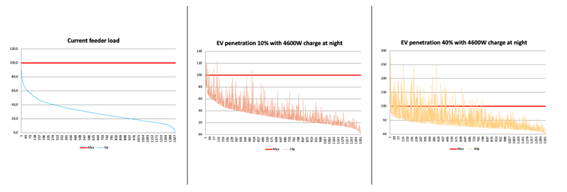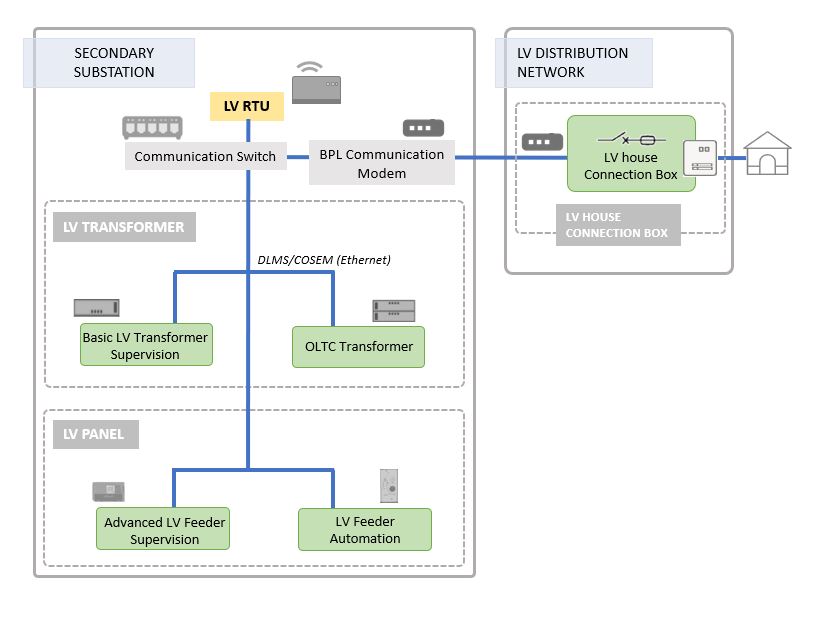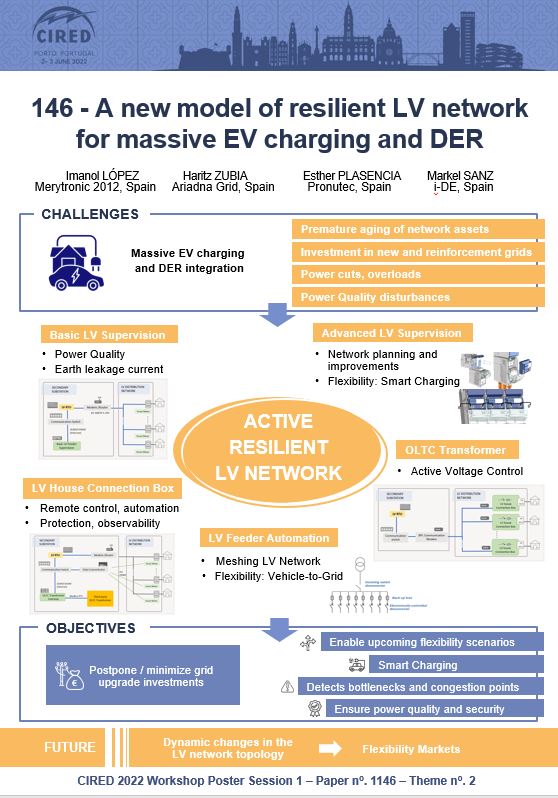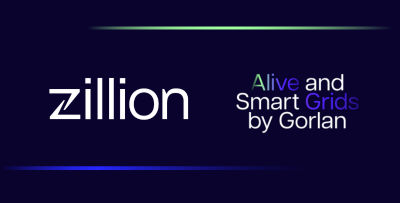
A new model of resilient LV network for massive EV charging and Distributed Generation
Paper presented at CIRED 2022 Porto Worshop.
Introduction
The increasing use of Electric Vehicles (EVs) is leading to an unstoppable transition on electrical distribution networks, where external charging stations are being deployed on a large-scale, as well as home charging, to accommodate the EV users’ needs. Therefore, the penetration of EV in the coming years will increase the electricity demand on the Low Voltage Distribution Network (commonly known as LV network). This LV network is typically not prepared to accommodate such a penetration in the coming years, because it requires large amounts of energy from the grid in short periods of time and with a variable demand profile resulting from a non-constant consumption. Moreover, there is a growing number of local renewable resources (Distribution Energy Resources or DER) connected to the distribution network that will affect the quality of the energy supply.
Monitoring systems for Low Voltage networks
Thus, monitoring the real-time operating conditions of LV networks in terms of power flows, phase unbalances, voltage levels, and other power quality indicators becomes essential to efficiently operate this kind of networks.
In order to check the resiliency of existing LV networks on progressive EV penetration scenarios, we have simulated the load increase on a large population of more than 1,300 LV feeders with a 6-month period of time, at the Secondary Substation LV panel level.

In terms of effectively managing LV distribution networks and the challenges presented, electric distribution companies need access to accurate and timely data. This abstract will introduce several solutions that can be implemented through the deployment of multiple electronic and electromechanical devices (all controlled in an Ethernet bus by an LV Remote Terminal Unit or LV RTU) and will be used for that real-time monitoring:
Basic / Advanced LV supervision
The Basic LV Supervision consists of a device which is installed to monitor the outgoing of the LV transformer of the Secondary Substation. The Advanced LV Supervision consists of several devices installed to monitor the status of each feeder, using three-phase current transformers and voltage taps for measurements of the LV switch -downstream the fuse-. Several functionalities/algorithms are performed based on collected data
>Network Planning and Planning Improvement: adding Smart Meters’ data, first an automatic grid topology discovery can be made, and afterwards a detailed power flow simulation of the grid is calculated, to find possible congestion points. As a result, e.g., this can determine if the grid can withstand a new customer connection, and decide whether to allow it directly or if first a network reinforcement needs to be done.
>Smart Charging: when an EV requires a fast load, an online power flow simulation is performed to find what would happen on the network power quality, indicating if that load will or not cause any problems, which may result on adjusting (reducing) the requested charging power (Smart Charging).
OLTC (On-Load Tap Changer) transformer
The OLTC transformer permits tap changing MV/LV distribution transformer ratio, so an active voltage control can be performed. The unpredictable oscillations inherent to the integration of EVs and DER can make it difficult to control the voltage level to end customers and therefore, maintain the limits established by local regulations. This transformer is a cost-effective alternative comparing with traditional grid reinforcements to facilitate these integrations.
LV feeder automation de BT
This solution replaces typical LV switchgears by a subset that consists on a backup fuse in series with a circuit breaker and an electronically-controlled disconnector per phase and feeder. It is used to perform control strategies (using switching capabilities) in case of massive EV charging, as well as to maintain protection capabilities. Additionally, it can be used in case of intermittent faults in LV network to recover client reconnecting the line automatically.
LV house connection box automation
It replaces typical LV house connection box by a remote controlled and automated breaker to enable advanced features (such as remote control, automation, protection and observability) and create a more resilient LV network (through reclosers and even a meshed LV network). It is an element installed out of the Secondary Substation that works in coordination with the systems that operate in it, through a Broadband Power Line (BPL) communication technology.

Summary
It is convenient to implement and deploy this kind of real-time monitoring and automation solutions to cope with these challenges, instead of reinforcing the grid using traditional passive network dimensioning methods. This will guarantee the efficient and safe operation of the networks, while maximizing the power availability to satisfy EV upcoming consumers’ needs

Poster Cired 2022 porto workshop
Related News
Introducing Zillion, our new Smart Grids ecosystem
At Gorlan, today we take a decisive step toward the future. We present Zillion, our...
Merytronic at Enlit Europe 2025
Enlit Europe 2025. Discover our Smart Grid solutions from 18 to 20 November in Bilbao....
How to digitise your Low Voltage network
How to digitise your Low Voltage network with Merytronic solutions: mapping and monitoring for network...









